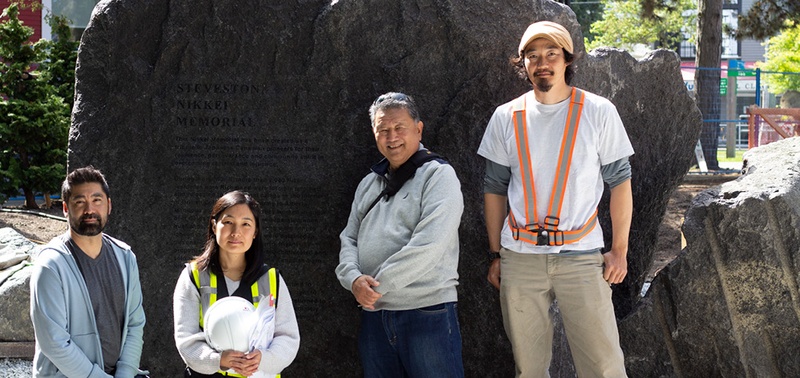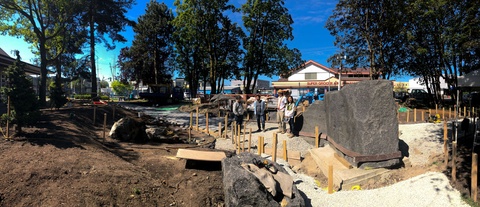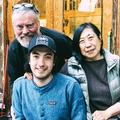Sitting at the mouth of the Fraser River, the village of Steveston, although technically part of Richmond, BC, retains a unique small town flavour. It’s a flavour that’s heavily influenced by the Japanese immigrants who before the war made up more than two-thirds of the population. Within a few square kilometres are found the Steveston Buddhist Temple, Steveston Martial Arts Centre, Steveston Japanese Canadian Cultural Centre, Murakami House, Kishi Boatworks, Kuno Gardens, Japanese fisherman’s statue, Japanese Hospital plaza, and T. K. Homma Elementary School, among other reminders of the key roll Japanese immigrants and their progeny played in the history of the town. The very existence of these landmarks pays tribute to the close, symbiotic relationship between the Japanese Canadian community and the Village of Steveston. While pre-war relations were often tense, and the return of the community following the lifting of restrictions in 1949 caused unease among some, the ensuing years have seen the Village becomes what Kelvin Higo calls, “the prime example of cultural harmony.”
On a warm Wednesday morning, I park my car by the Japanese Hospital plaza and walk onto a fenced-off site at the corner of No. 1 Road and Moncton for a private tour of the new Steveston Nikkei Memorial, still very much under construction, but never-the-less taking shape. Joseph Fry, Kelvin Higo, Hanako Amaya and Hayato Ogawa are waiting for me, standing the shadow at two large black boulders that sit nestled together in a sea of gravel. A few steps away, grey, patterned tiles form a partially-finished path that winds through the site, linking the other elements.
The Steveston Nikkei Memorial project had its genesis in 2017 as a way of marking the 75th anniversary of the removal of the Japanese Canadians from the West Coast. The initial concept was a statue that would sit by the Tram Building, the location where Nikkei left the community between April and May, 1942. City Council approved a grant of $325,000, with the Steveston Community Society donating another $20,000.
The parternship between the City of Richmond, the NNM&CC and the Steveston Community Society created a steering committee to select an artist to undertake the project, with the Hapa Collaborative, led by Joseph Fry, winning the bid.
In its final iteration, the memorial hugs the gentle contours of the site, with trees and grass creating a backdrop for the path, the soon-to-be-planted plum tree, and the boulders that are engraved with the history of the community – its expulsion and eventual return.
While three three small boulders were sourced from Tashme, the centre-piece black-coloured boulders come from Quebec. The largest is engraved with the names of the primary internment sites with other markers representing the work camps, the sugarbeat farms, the self-supporting camps and the Ontario POW camps.
Running my hands across the face of the boulder, the tactile nature of the map somehow reinforces the vastness of the land where the Japanese Canadians were exiled, and the rugged beauty of its mountains, rivers and lakes.
Kelvin points out that as part of the fundraising activities, it was determined that a Steveston Nikkei Memorial Legacy Fund should be created to fund education and cultural activities related to the Nikkei community.“We felt it was difficult enough to entice new volunteers without them also having to worry about funding projects or initiatives they wished to pursue. A goal of $100,000 was established and a partnership with the Nikkei National Museum & Cultural Centre was created.”
Talking to Kelvin, what comes up over and over is the concept of working together and the support that the project has received across the board. It is, he points out, the result of good will and trust built up over many years. That spirit of cooperation and dedication is also evident in talking to Joe, Hanako and Hayato – this is truly a labour of love for all the particiants. It is fitting, too, that the project is bringing together contibutors that represent the different aspects of today’s Canadian Nikkei community, where birthplace is but one factor in a connection that crosses oceans, mountains and forests and finds common cause in respect for the pioneers who built today’s community and a desire to honour them.
The unveiling of the memorial was held on Saturday, June 22, nine months to the day from the project’s launch.
Bulletin Interview with Joseph Fry, Kelvin Higo, Hanako Amaya, and Hayato Ogawa
Kelvin, you’ve put a lot into this community over the years, what does this project mean to you?
Kelvin: I am already involved in other activities serving the senior Nikkei community in Richmond. These programs include the weekly Iki Iki program, the monthly Nikkei seniors lunches. I always say that I am in awe of our parents and grandparents who suffered much racism and injustice trying to establish themselves in Canada. Being affiliated for over 37 years with the Steveston Community Center, I’m very aware of the contribution that the Nikkei pioneers made to help build the first community centre in Richmond. I always wonder if I could have been so forgiving as these community elders. I gained so much respect for these pioneers and wish to do as much as I can to make their lives more enjoyable.
I think this memorial will finally recognize the injustice perpetuated on the Nikkei community and hopefully will stand as a symbol against the racism and xenophobia that we are seeing on the rise throughout the world. I am very proud that the community and City Council share the same vision my committee had when we embarked on this journey.
The completion of this project in 2019, which is the 70th anniversary of the return of the Nikkei to Steveston, is probably more important as it shows the resilience, perseverance and community building that we wanted to embody in this memorial.
How did the memorial change from conception to completion?
Joe: The direction hasn’t changed much for us from our initial concept to the installation, but we did have to change the way we described the project to respond to the committee’s comments and concerns. Generally the three elements – the boulder, the paving, and the trees – carry a symbolism that needed to be made more evident or obvious in the design and the composition. We feel that public art and landscape architecture is about first provoking a curiosity in the place, and then satisfying that curiosity in the details. It shouldn’t be a one-liner but something that is subtle and nuanced. So trying to strike a balance between those things took time to develop.
Secondly, we always felt that the memorial really should not be a singular sculpture or object, but that the entire space – the existing trees, the shallow grading down into the centre of the site, the shaping of the lawn to contain the inner space – is all part of the commemorative moment. That concept has remained intact the entire time, although we made a lot of adjustments as construction has progressed.
What’s the significance of the spot you chose for the memorial?
Kelvin: I felt strongly that the site next to the Tram Building needed to be part of the design as it is where over 2,000 Nikkei left this community but only around 800 returned.
Joe, what does this project mean to you on a personal level?
Joe: It is really hard to express how privileged I feel to be involved, and how much the committee’s own desires for this project were in synch with my own personal aspirations. We talked a lot about the role of women in the community during the internment years – my grandmother’s generation, and also the importance to communicate and explain that experience to fourth and fifth generation Japanese Canadians. To be able to create a memorial that stretches out in both directions on the timeline, to be a honorific for my grandparents and my mom, but to also serve as an interpretation and reminder for my own son and daughter, is really satisfying.
There’s a lot of symbolism in the various aspects of the Memorial. I’m particularly intrigued by the tiled walkway, or path. Where did the inspiration for that come from?
Joe: During the internment years many women made placemats, baskets and coasters from labels salvaged from salmon cans. When we were meeting with the community and doing our research, we met with a craft group of women in their 90s and older, who are still making these placemats and baskets. We felt that act of weaving, this quiet act of defiance – creating domestic normalcy and beauty in terrible conditions – is a reminder of the understated strength and resilience of the Issei and Nissei wives, mothers and daughters who were the anchors and community leaders during the internment years while the men were often away working on road camps. The weaving pattern – ishidatami ami – meaning ‘stone weave paving,’ is actually based on a garden path paving pattern, so we felt that this was a very appropriate way of honouring their stories, and referencing their craft, which still continues today.
The tiles create this beautiful path that links the other elements – including the large black boulders that dominate the space. How did you choose the boulders?
Joe: I’ve had the privilege of working with designers like Robert Murase, a Japanese American landscape architect, and stone masons in Vancouver and Seattle, who have helped shape my attitude towards commemorative work. The works of Isamu Noguchi and Shunmyo Masuno are very inspirational to me and they show up in a lot of our research. So stone is an immediate and obvious choice. We started by looking at the sites of internment for stone sources, and we were pleased to work directly with Ryan Ellan at the Tashme Museum to procure three boulders from the Hope Slide site. We also looked in the Interior around Nelson and the Slocan Valley, but couldn’t find boulders of the size or colour that we wanted, plus they tended to be fractured rock. We also looked for Precambrian granite in Ontario near Angler but also were limited in size and colour and also access. We ended up working with Polycor out of Quebec and found beautiful large pieces of black Mesabi granite that were perfect for the effect we wanted. To be able to site these boulders in Steveston – travelling from back east as many Japanese internees once did – is part of the story we wanted to tell.
It’s beautiful the way the names of the various camps are carved into the black, uneven surface of the stone, almost like they’re hugging the contours of the land – tell me about how you chose to represent the scattering of the community across the country.
Joe: As was the case everything with this project, we did a lot of careful research to determine the names that would be engraved while also acknowledging that the scattering of families was very broad and disparate. We worked with the committee and with Sherri Kajiwara at the Nikkei Museum to focus the engraved placenames on the specifically registered internment sites in BC, as well as the two POW camps in Ontario. The smaller bronze markers represent the many other communities in Alberta and the BC Interior where Japanese were relocated. We felt that they are just as critical to the constellation of places that needed to be represented. We reserved the largest marker for Steveston as this was uniquely a community that rebuilt after the war, and – as Kelvin very passionately describes – were critical to the creation of many Steveston institutions immediately after their return.
Tell me a little about your family’s story.
Joe: My grandfather, John Shinichi Maeba, was a printer for the New Canadian on Alexander Street, he and my grandmother moved to Slocan from 1942 to 1945, my mom was born there in 1943, then they moved to Neys in Northern Ontario temporarily until he found work in Geraldton as a printer for the local paper. My mom grew up there, met my dad there, and I was born there.
We are still trying to build a similar commemorative garden at Neys, a matsutake garden. Neys is now a provincial park with lots of visitors – a good place to commemorate sites of internment including Neys, Angler and Camp 78 where several Japanese Canadian families lived for at least one winter before relocating to southern Ontario.
Kelvin, You talked earlier about what the project means to you – what about the Steveston community at large. How does this Memorial fit within the grand scheme of things, in terms of communities co-existing?
Kelvin: The Canadian multi-cultural policy promotes ethnic groups to maintain their own cultural identity while being part of the wider Canadian community. In Steveston this is apparent in all the projects and programs we provide. The membership of most of the Nikkei organizations, such as our martial arts clubs and Japanese Language School, are made up of many non-Japanese members. I think in sharing some of our culture, this promotes cultural harmony and understanding.
I think this memorial is another component within our community that strengthens and re-enforces the contributions made by the Nikkei to better our community.
I understand that there will be an interactive component that ties in with a larger initiative within Steveston.
Kelvin: The City is undertaking a project of which we are the first to partake, in utilizing technology to improve information. We will be installing iBeacons on the site which will tell a bit more of the story behind internment and what this memorial means. There will be three iBeacons so that they do not overlap their signals. One will be by the dedication rock, one by the larger boulders and one in the Tram Building. Eventually it is planned to have more beacons throughout Steveston to tell the bigger historical story throughout the village.
Hanako, you did a survey of local residents – can you talk about that, and what this project means to you?
Hanako: I am originally from Japan, and until our firm started working on this project, my knowledge of Japanese Canadian internment during WW II was very limited. In the beginning of the project, it was shocking to find out the in-depth details of what happened to the community.
We started from typical workshop-style community engagement with key stakeholders. We also made cards with six very simple questions: How did you arrive in Steveston? How old are you? What do you remember? What have you forgotten? What do you wish for? What do you worry about?
The results were amazing. The majority of people over 80 years old, who experienced the war, responded that they don’t have any wishes for themselves, just wishes for their family and community’s happiness. In contrast to this, many people under 80 years, who are children and grandchildren of the pioneers, responded that they appreciate how hard their parents and grandparents worked to re-establish their community. The responses were as if they are talking to each other.
I felt that we found the answer to how the community overcame the traumatic experience. We also interviewed key individuals from the community to listen to their personal stories. Community members generously shared their family stories. I felt very privileged to meet and listen to the stories that many parents didn’t even share with their children. I could also hear many seniors’ stories of internment camps or even POWs. I probably would never have had a chance to hear their voices directly without this project. The stories were emotional and heartbreaking, but at the same time, almost everybody mentioned that they are very proud of the tight-knit and caring community.
From working on this project, I feel that our clients taught us that the racism is not a story from the past nor was it only experienced by to the Japanese Canadian community, it is a contemporary issue all over the world. Now I have joined the Community Relations Committee at the Japanese Language School and the Hall where my two kids go and take classes. It has been very rewarding to be involved in the committee, where I feel welcomed and encouraged to advocate for human rights.
Hayato, You’ve done a lot of the heavy lifting (literally!) on this project. Where did you learn your trade. You’re Japanese, but this is a very Canadian project. What have you learned, working with Joe and Kelvin on pulling this all together? What has been the biggest challenge?
Hayato: I was trained as a gardener at a traditional Japanese gardening company specialized in rock gardens in Kyoto, Japan. I relocated to Canada in 2004 and became a permanent resident in 2006. Shortly after, I started my own company called Ogawa Landscape Design. Time flies. It has been almost 20 years since I started working in this field.
Most Japanese people in Japan don’t know the details of the Canadian government’s Immigration Act (Japanese Exclusion Act) of 1924. I was not an exception. However, after being contracted to this work, I heard Joe’s family story, read books and went to the Tashme museum in Sunshine Valley near Hope. As my understanding of the event deepened, I decided to commit myself to sincerely express these voices and stories though the garden.
Just like Joe, Kelvin, and Hanako, my two daughters were born in Canada. Although we are family, we have different nationalities. The differences between countries and identities make this project more complex. The world is heading towards more protectionism and I hope Kelvin and Joe’s message of inclusion through this project will become a lesson to the world.
The biggest challenge in this project was laying the stone monument during the construction work. The stone was over 16 tons and had to be lifted with a huge crane. We had limited time to place the stone as No. 1 Road was closed to make room for the crane. Another important element of the garden is the stone pathways. As I carefully set the stone pavers one by one, I thought of the Japanese mothers who made origami placemats in the internment camps. This work was quite delicate and even a slight mistake could not be tolerated. I am very proud to have be trusted to be build this garden and honoured to be involved in the project.
*This article was originally published on The Bulletin: a journal of Japanese Canadiann on May 31, 2019.
© 2019 The Bulletin / John Endo Greenaway







